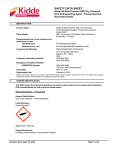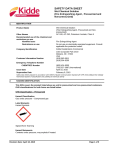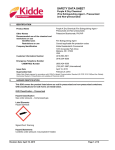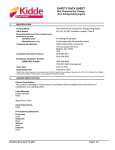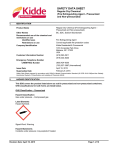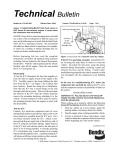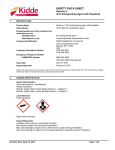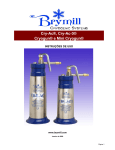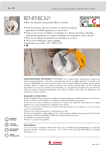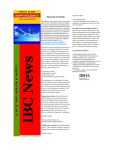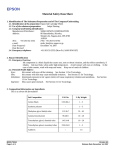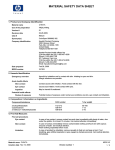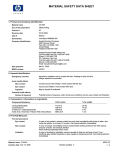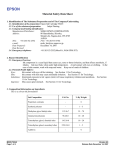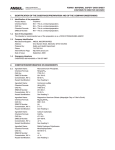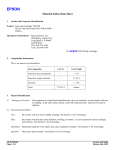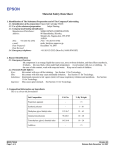Download Kidde 466425 Data Sheet
Transcript
SAFETY DATA SHEET Commercial ABC Dry Chemical (Fire Extinguishing Agent, Pressurized and Non-pressurized) 1. IDENTIFICATION Product Name Other Names Recommended use of the chemical and restrictions on use Identified uses Restrictions on use Company Identification Customer Information Number Emergency Telephone Number CHEMTREC Number Issue Date Supersedes Date Commercial ABC Dry Chemical (Fire Extinguishing Agent, Pressurized and Nonpressurized) Multi-Purpose, Ammonium Phosphate, Monoammonium Phosphate Fire Extinguishing Agent Consult applicable fire protection codes Kidde Residential & Commercial 1016 Corporate Park Drive Mebane, NC 27302 USA (919) 563-5911 (919) 304-8200 (800) 424-9300 (703) 527-3887 (International) April 10, 2015 February 9, 2015 Safety Data Sheet prepared in accordance with OSHA’s Hazard Communication Standard (29 CFR 1910.1200)and the Globally Harmonized System of Classification and Labelling of Chemicals (GHS) 2. HAZARD IDENTIFICATION This SDS covers the product listed above as sold in pressurized and non-pressurized containers. GHS classifications for both forms are listed below. GHS Classification – Pressurized Hazard Classification Gas under pressure – Compressed gas Label Elements Hazard Symbols Signal Word: Warning Hazard Statements Contents under pressure; may explode if heated. Revision Date: April 10, 2015 Page 1 of 10 SAFETY DATA SHEET Commercial ABC Dry Chemical (Fire Extinguishing Agent, Pressurized and Non-pressurized) 2. HAZARD IDENTIFICATION Precautionary Statements Prevention None Response None Storage Protect from sunlight. Store in well-ventilated place. Disposal None GHS Classification: Non - pressurized Hazard Classification This product is classified as not hazardous in accordance with the Globally Harmonized System of Classification and Labelling (GHS). Label Elements Hazard Symbols None Signal Word: None Hazard Statements None Precautionary Statements Prevention None Response None Storage None Disposal None Other Hazards Mica may contain small quantities of quartz (crystalline silica) as an impurity. Prolonged exposure to respirable crystalline silica dust at concentrations exceeding the occupational exposure limits may increase the risk of developing a disabling lung disease known as silicosis. IARC found limited evidence for pulmonary carcinogenicity of crystalline silica in humans. Specific Concentration Limits The values listed below represent the percentages of ingredients of unknown toxicity. Acute oral toxicity < 10% Acute dermal toxicity < 10% Acute inhalation toxicity < 10% Acute aquatic toxicity < 10% Revision Date: April 10, 2015 Page 2 of 10 SAFETY DATA SHEET Commercial ABC Dry Chemical (Fire Extinguishing Agent, Pressurized and Non-pressurized) 3. COMPOSITION/INFORMATION ON INGREDIENTS This product is a mixture. Component Monoammonium Phosphate Ammonium Sulfate Mica Clay Amorphous Silica Dye CAS Number 7722-76-1 471-34-1 12001-26-2 1332-58-7 7631-86-9 NA Concentration 55 - 65% 30 - 40% < 5% < 5% < 5% <1% Note: Pressurized product uses nitrogen or compressed air as the expellant. 4. FIRST- AID MEASURES Description of necessary first-aid measures Eyes Immediately flood the eye with plenty of water for at least 15 minutes, holding the eye open. Obtain medical attention if soreness or redness persists. Skin Wash skin thoroughly with soap and water. Obtain medical attention if irritation persists. Ingestion Dilute by drinking large quantities of water and obtain medical attention. Inhalation Move victim to fresh air. Obtain medical attention immediately for any breathing difficulty. Most important symptoms/effects, acute and delayed Aside from the information found under Description of necessary first aid measures (above) and Indication of immediate medical attention and special treatment needed, no additional symptoms and effects are anticipated. Indication of immediate medical attention and special treatment needed Notes to Physicians Treat symptomatically. 5. FIRE - FIGHTING MEASURES Suitable Extinguishing Media This preparation is used as an extinguishing agent and therefore is not a problem when trying to control a fire. Use extinguishing agent appropriate to other materials involved. Keep pressurized containers and surroundings cool with water spray as they may rupture or burst in the heat of a fire. Specific hazards arising from the chemical Pressurized containers may explode in heat of fire. Special Protective Actions for Fire-Fighters Wear full protective clothing and self-contained breathing apparatus as appropriate for specific fire conditions. Revision Date: April 10, 2015 Page 3 of 10 SAFETY DATA SHEET Commercial ABC Dry Chemical (Fire Extinguishing Agent, Pressurized and Non-pressurized) 6. ACCIDENTAL RELEASE MEASURES Personal precautions, protective equipment and emergency procedures Wear appropriate protective clothing. Prevent skin and eye contact. Remove leaking container to a safe place. Ventilate the area. Environmental Precautions Prevent large quantities of the material from entering drains or watercourses. Methods and materials for containment and cleaning up Sweep up or vacuum and transfer into suitable containers for recovery or disposal. 7. HANDLING AND STORAGE Precautions for safe handling Wear appropriate protective clothing. Prevent skin and eye contact. Conditions for safe storage Pressurized containers should be properly stored and secured to prevent falling or being knocked over. Do not drag, slide or roll pressurized containers. Do not drop pressurized containers or permit them to strike against each other. Never apply flame or localized heat directly to any part of the pressurized or plastic container. Store pressurized and plastic containers away from high heat sources. Storage area should be: - cool - dry - well ventilated - under cover - out of direct sunlight 8. EXPOSURE CONTROLS/PERSONAL PROTECTION Control parameters Exposure limits are listed below, if they exist. Mica ACGIH TLV: 3 mg/m3 TWA, measured as respirable fraction of the aerosol. OSHA PEL: 20 mppcf, <1% crystalline silica Clay as Kaolin, Respirable Fraction ACGIH TLV: 2 mg/m3 TWA OSHA PEL: 15 mg/m3 TWA, total dust 5 mg/m3 TWA, respirable fraction Nuisance Dust Limit OSHA PEL: 50 mppcf or 15 mg/m3 TWA, total dust 15 mppcf or 5 mg/m3 TWA, respirable fraction Appropriate engineering controls Use with adequate ventilation. If this product is used in a pressurized system, there should be local procedures for the selection, training, inspection and maintenance of this equipment. When used in large volumes, use local exhaust ventilation. Individual protection measures Respiratory Protection Not normally required. Use dust mask where dustiness is prevalent, or TLV is exceeded. In oxygen deficient atmospheres, use a self contained breathing apparatus, as an air purifying respirator will not provide protection. Revision Date: April 10, 2015 Page 4 of 10 SAFETY DATA SHEET Commercial ABC Dry Chemical (Fire Extinguishing Agent, Pressurized and Non-pressurized) 8. EXPOSURE CONTROLS/PERSONAL PROTECTION Skin Protection Gloves Eye/Face Protection Chemical goggles or safety glasses with side shields. Body Protection Normal work wear. 9. PHYSICAL AND CHEMICAL PROPERTIES Non- Pressurized Appearance Physical State Color Odor Odor Threshold pH Specific Gravity Boiling Range/Point (°C/F) Melting Point (°C/F) Flash Point (PMCC) (°C/F) Vapor Pressure Evaporation Rate (BuAc=1) Solubility in Water Vapor Density (Air = 1) VOC (g/l) VOC (%) Partition coefficient (noctanol/water) Viscosity Auto-ignition Temperature Decomposition Temperature Upper explosive limit Lower explosive limit Flammability (solid, gas) Expellant - Nitrogen Appearance Physical State Color Odor Odor Threshold pH Specific Gravity Boiling Range/Point (°C/F) Melting Point (°C/F) Flash Point (PMCC) (°C/F) Vapor Pressure Evaporation Rate (BuAc=1) Solubility in Water Revision Date: April 10, 2015 Solid (powder) Pale Yellow Odorless No data available Not applicable No data available Not applicable No data available Not flammable No data available No data available No data available Not applicable None None No data available No data available No data available No data available No data available No data available No data available Compressed gas Colorless None No data available Not applicable 0.075 lb/ft3 @70oF as vapor -196oC/-321 oF No data available Not flammable No data available No data available No data available Page 5 of 10 SAFETY DATA SHEET Commercial ABC Dry Chemical (Fire Extinguishing Agent, Pressurized and Non-pressurized) 9. PHYSICAL AND CHEMICAL PROPERTIES Vapor Density (Air = 1) VOC (g/l) VOC (%) Partition coefficient (noctanol/water) Viscosity Auto-ignition Temperature Decomposition Temperature Upper explosive limit Lower explosive limit Flammability (solid, gas) 10. Not applicable None None No data available Not applicable No data available No data available Not explosive Not explosive Not flammable STABILITY AND REACTIVITY Reactivity Pressurized containers may rupture or explode if exposed to heat. Chemical Stability Stable under normal conditions. Possibility of hazardous reactions Hazardous polymerization will not occur. Conditions to Avoid Exposure to direct sunlight - contact with incompatible materials Incompatible Materials Strong oxidizing agents - strong acids - sodium hypochlorite Hazardous Decomposition Products Oxides of carbon - ammonia - oxides of phosphorus - nitrogen oxides 11. TOXICOLOGICAL INFORMATION Acute Toxicity Monoammonium Phosphate: Oral LD50 (Rat) 5750 mg/kg Dermal LD50 (Rabbit) >5000mg/kg Inhalation LC50 (Rat) 5.1mg/l Ammonium Sulfate: Oral LD50 (Rat) 4250 mg/kg Dermal LD50 (Rabbit) >2000mg/kg Mica: Oral LD50 (Rat) >2000 mg/kg Amorphous Silica: Oral LD50 (Rat) >5000 mg/kg Dermal LD50 (Rabbit) >2000mg/kg Revision Date: April 10, 2015 Page 6 of 10 SAFETY DATA SHEET Commercial ABC Dry Chemical (Fire Extinguishing Agent, Pressurized and Non-pressurized) 11. TOXICOLOGICAL INFORMATION Clay: Oral LD50 (Rat) >5000 mg/kg Dermal LD50 (Rabbit) >5000mg/kg Nitrogen Simple asphyxiant Specific Target Organ Toxicity (STOT) – single exposure Monoammonium Phosphate: Available data indicates this component is not expected to cause target organ effects after a single exposure. Ammonium Sulfate: Available data indicates this component is not expected to cause target organ effects after a single exposure. Nitrogen: Exposure to nitrogen gas at high concentrations can cause suffocation by reducing oxygen available for breathing. Breathing very high concentrations can cause dizziness, shortness of breath, unconsciousness or asphyxiation. Specific Target Organ Toxicity (STOT) – repeat exposure Monoammonium Phosphate: Available data indicates this component is not expected to cause target organ effects after repeat exposure. Ammonium Sulfate: Available data indicates this component is not expected to cause target organ effects after repeat exposure. Serious Eye damage/Irritation Monoammonium Phosphate: Not irritating (rabbit) Ammonium Sulfate: Not irritating (rabbit) Mica: Not irritating (rabbit) Skin Corrosion/Irritation Monoammonium Phosphate: Not irritating in rabbit test study Ammonium Sulfate: Not irritating (rabbit) Mica: Not irritating (rabbit) Respiratory or Skin Sensitization Monoammonium Phosphate: Not skin sensitizing based on test (Mouse local lymphnode assay (LLNA)) on an analogous compound Ammonium Sulfate: Not sensitizing in Guinea pig maximisation test Carcinogenicity Mica may contain small quantities of quartz (crystalline silica) as an impurity. Prolonged exposure to respirable crystalline silica dust at concentrations exceeding the occupational exposure limits may increase the risk of developing a disabling lung disease known as silicosis. IARC has classified Silica Dust, Crystalline, in the form of quartz or cristobalite as 1 (carcinogenic to humans). Germ Cell Mutagenicity Monoammonium Phosphate: Not mutagenic in the mouse lymphoma cells in mammalian cell gene mutation assay Ammonium Sulfate: Negative results in Ames Test, in vitro mammalian chromosome aberration test, and mammalian cell gene mutation assay. Revision Date: April 10, 2015 Page 7 of 10 SAFETY DATA SHEET Commercial ABC Dry Chemical (Fire Extinguishing Agent, Pressurized and Non-pressurized) 11. TOXICOLOGICAL INFORMATION Reproductive Toxicity Monoammonium Phosphate: Available data indicates this component is not expected to cause reproductive toxicity or birth defects. Ammonium Sulfate: Available data indicates this component is not expected to cause reproductive toxicity or birth defects. Aspiration Hazard Not an aspiration hazard. 12. ECOLOGICAL INFORMATION Ecotoxicity Monoammonium Phosphate: LC50 rainbow trout >100 mg/l 96h LC50 water flea 1790 mg/l 72h (similar substance) Mobility in soil No relevant studies identified. Persistence/Degradability No relevant studies identified. Bioaccumulative Potential No relevant studies identified. Other adverse effects No relevant studies identified. 13. DISPOSAL CONSIDERATIONS Disposal Methods Dispose of container in accordance with all applicable local and national regulations. 14. TRANSPORT INFORMATION Safety Data Sheet information is intended to address a specific material and not various forms or states of containment. Specific volumes, pressures or hardware configurations containing such materials can dictate various different hazard classifications for transportation and labelling requirements. Under Federal Regulations only trained and qualified individuals are permitted to label and ship products following the applicable Department of Transportation (DOT), Federal Aviation Administration (FAA), Transport Canada (TC), International Maritime Dangerous Goods (IMDG) or International Air Transport Association (IATA) requirements. 15. REGULATORY INFORMATION United States TSCA Inventory This product contains ingredients that are listed on or exempt from listing on the EPA Toxic Substance Control Act Chemical Substance Inventory. Revision Date: April 10, 2015 Page 8 of 10 SAFETY DATA SHEET Commercial ABC Dry Chemical (Fire Extinguishing Agent, Pressurized and Non-pressurized) 15. REGULATORY INFORMATION Canada DSL Inventory All ingredients in this product are listed on the Domestic Substance List (DSL) or the Non-Domestic Substance List (NDSL) or are exempt from listing. SARA Title III Sect. 311/312 Categorization: Pressurized Pressure hazard SARA Title III Sect. 311/312 Categorization: Non-pressurized None SARA Title III Sect. 313 This product does not contain any chemicals that are listed in Section 313 at or above de minimis concentrations. 16. OTHER INFORMATION NFPA Ratings NFPA Code for Health - 1 NFPA Code for Flammability - 0 NFPA Code for Reactivity - 0 NFPA Code for Special Hazards - None HMIS Ratings HMIS Code for Health - 1 HMIS Code for Flammability - 0 HMIS Code for Physical Hazard - 0 HMIS Code for Personal Protection - See Section 8 *Chronic Legend ACGIH: American Conference of Governmental Industrial Hygienists CAS#: Chemical Abstracts Service Number EC50: Effect Concentration 50% IARC: International Agency for Research on Cancer LC50: Lethal Concentration 50% LD50: Lethal Dose 50% N/A: Denotes no applicable information found or available OSHA: Occupational Safety and Health Administration PEL: Permissible Exposure Limit STEL: Short Term Exposure Limit TLV: Threshold Limit Value TSCA: Toxic Substance Control Act Revision Date: April 10, 2015 Replaces: February 9, 2015 Changes made: Updated to GHS Classification. Information Source and References This SDS is prepared by Hazard Communication Specialists based on information provided by internal company references. Revision Date: April 10, 2015 Page 9 of 10 SAFETY DATA SHEET Commercial ABC Dry Chemical (Fire Extinguishing Agent, Pressurized and Non-pressurized) 16. OTHER INFORMATION Prepared By: EnviroNet LLC. The information and recommendations presented in this SDS are based on sources believed to be accurate. Kidde Residential & Commercial assumes no liability for the accuracy or completeness of this information. It is the user's responsibility to determine the suitability of the material for their particular purposes. In particular, we make NO WARRANTY OF MERCHANTABILITY OR ANY OTHER WARRANTY, EXPRESS OR IMPLIED, with respect to such information, and we assume no liability resulting from its use. Users should ensure that any use or disposal of the material is in accordance with applicable Federal, State, and local laws and regulations. Revision Date: April 10, 2015 Page 10 of 10










